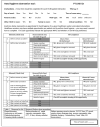Hand Hygiene Compliance in the Setting of Trauma Resuscitation
- PMID: 27568844
- PMCID: PMC5711429
- DOI: 10.1016/j.injury.2016.08.004
Hand Hygiene Compliance in the Setting of Trauma Resuscitation
Abstract
Introduction: Healthcare-associated infections are a significant health burden, and hand hygiene (HH) is an essential prevention strategy. World Health Organization (WHO) 2009 guidelines recommend washing hands during five moments of patient care; 1)before touching a patient; 2)before a clean procedure; 3)after body fluid exposure; and 4)after touching a patient or 5)patient surroundings. HH opportunities at these 5 moments are frequent and compliance is low (22-60%). Infection risk is particularly high in trauma patients, and HH compliance during active trauma resuscitation has yet to be evaluated.
Materials and methods: Using video surveillance, all healthcare worker (HCW)-patient interactions for 30 patients were retrospectively reviewed for HH compliance according to WHO guidelines and glove use during initial resuscitation at a level-1 trauma center.
Results: 342 HCW-patient interactions and 1034 HH opportunities were observed. HH compliance with the WHO moments was 7% (71/1034) overall; 3% (10/375) before patient contact, 0% (0/178) before a clean procedure, 11% (2/19) after body fluid contact, 15% (57/376) after patient contact and 2% (2/86) after contact with the environment. Glove use was more common, particularly before (69%) and after (47%) patient contact and after body fluid contact (58%). No HH was observed before clean procedures, but HCW donned new gloves 75% of the time before bedside procedures. If donning/removing gloves was included with HH as compliant, compliance was 57% overall.
Conclusion: HH opportunities are frequent and compliance with WHO HH guidelines may be infeasible, requiring significant amounts of time that may be better spent with the patient during the golden hour of trauma resuscitation. In an era where more scrutiny is being applied to patient safety, particularly the prevention of inpatient infections, more research is needed to identify alternative strategies (e.g. glove use, prioritizing moments) that may more effectively promote compliance in this setting.
Keywords: Compliance; Critical Care; Hand Hygiene; Resuscitation; Trauma.
Copyright © 2016 Elsevier Ltd. All rights reserved.
Similar articles
-
Beyond entry and exit: Hand hygiene at the bedside.Am J Infect Control. 2019 May;47(5):487-491. doi: 10.1016/j.ajic.2018.10.026. Epub 2018 Dec 21. Am J Infect Control. 2019. PMID: 30584017
-
Hand hygiene in surgery in Benin: opportunities and challenges.Antimicrob Resist Infect Control. 2020 Jun 15;9(1):85. doi: 10.1186/s13756-020-00748-z. Antimicrob Resist Infect Control. 2020. PMID: 32539867 Free PMC article.
-
Enhancing infection prevention and control through hand hygiene compliance in six Ugandan hospitals using quality improvement approaches.Front Public Health. 2024 Oct 22;12:1465439. doi: 10.3389/fpubh.2024.1465439. eCollection 2024. Front Public Health. 2024. PMID: 39502813 Free PMC article.
-
Irritant Contact Dermatitis on Hands.Am J Med Qual. 2017 Jan/Feb;32(1):93-99. doi: 10.1177/1062860615611228. Epub 2016 Jul 9. Am J Med Qual. 2017. PMID: 26472960 Review.
-
Barriers to hand hygiene practices among health care workers in sub-Saharan African countries: A narrative review.Am J Infect Control. 2019 May;47(5):565-573. doi: 10.1016/j.ajic.2018.09.014. Epub 2018 Nov 20. Am J Infect Control. 2019. PMID: 30470526 Review.
Cited by
-
Alcohol-based decontamination of gloved hands: A randomized controlled trial.Infect Control Hosp Epidemiol. 2024 Apr;45(4):467-473. doi: 10.1017/ice.2023.243. Epub 2023 Nov 23. Infect Control Hosp Epidemiol. 2024. PMID: 37994538 Free PMC article. Clinical Trial.
-
Healthcare Personnel Hand Hygiene Compliance: Are We There Yet?Curr Infect Dis Rep. 2023 May 26:1-7. doi: 10.1007/s11908-023-00806-8. Online ahead of print. Curr Infect Dis Rep. 2023. PMID: 37361491 Free PMC article. Review.
-
World Hand Hygiene Day 2025: A perspective from the Infection Prevention in Practice Editors.Infect Prev Pract. 2025 Apr 26;7(2):100465. doi: 10.1016/j.infpip.2025.100465. eCollection 2025 Jun. Infect Prev Pract. 2025. PMID: 40469225 Free PMC article. No abstract available.
-
Indications for hand and glove disinfection in Advanced Cardiovascular Life Support: A manikin simulation study.Front Med (Lausanne). 2023 Jan 6;9:1025449. doi: 10.3389/fmed.2022.1025449. eCollection 2022. Front Med (Lausanne). 2023. PMID: 36687411 Free PMC article.
-
Hand hygiene practices for prevention of health care-associated infections associated with admitted infectious patients in the emergency department: a systematic review.Ir J Med Sci. 2023 Apr;192(2):871-899. doi: 10.1007/s11845-022-03004-y. Epub 2022 Apr 18. Ir J Med Sci. 2023. PMID: 35435564 Free PMC article.
References
-
- Allegranzi B, Bagheri Nejad S, Combescure C, et al. Burden of endemic health-care associated infection in developing countries: systematic review and meta-analysis. Lancet. 2011 Jan 15;377(9761):228–41. - PubMed
-
- Al-Rawajfah OM, Hewitt JB, Stetzer F, et al. Length of stay and charges associated with health care-acquired bloodstream infections. Am J Infect Control. 2012 Apr;40(3):227–32. - PubMed
-
- Zimlichman E, Henderson D, Tamir O, et al. Health care-associated infections: a meta-analysis of costs and financial impact on the US health care system. JAMA Intern Med. 2013 Dec 9-23;173(22):2039–46. - PubMed
-
- Vrijens F, Hulstaert F, Devriese S, et al. Hospital-acquired infections in Belgian acute-care hospitals: an estimation of their global impact on mortality, length of stay and healthcare costs. Epidemiol Infect. 2012 Jan;140(1):126–36. - PubMed
-
- Roberts RR, Scott RD, Hota B, et al. Costs attributable to healthcare-acquired infection in hospitalized adults and a comparison of economic methods. Med Care. 2010 Nov;48(11):1026–35. - PubMed
MeSH terms
Grants and funding
LinkOut - more resources
Full Text Sources
Other Literature Sources
Medical


